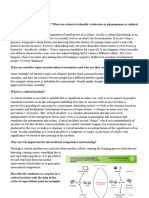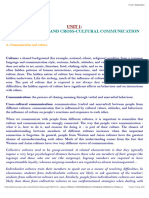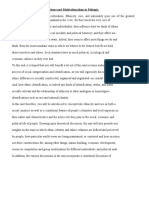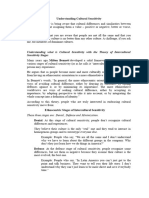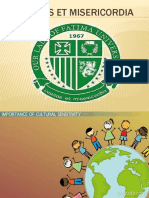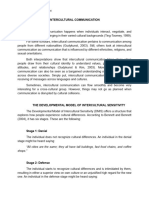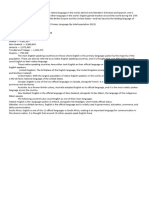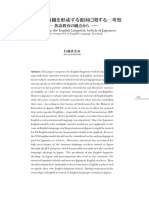0 ratings0% found this document useful (0 votes)
5 viewsBecoming Interculturally Competent
Becoming Interculturally Competent
Uploaded by
Guranda IobashviliThe document discusses the Developmental Model of Intercultural Sensitivity (DMIS), which proposes six stages or orientations that people progress through as they become more interculturally competent. These stages range from more ethnocentric views that avoid or deny cultural differences to more ethnorelative views that seek to understand differences. The initial three stages - Denial, Defense, and Minimization - represent ethnocentric perspectives, while Acceptance, Adaptation, and Integration are more ethnorelative.
Copyright:
© All Rights Reserved
Available Formats
Download as PDF, TXT or read online from Scribd
Becoming Interculturally Competent
Becoming Interculturally Competent
Uploaded by
Guranda Iobashvili0 ratings0% found this document useful (0 votes)
5 views13 pagesThe document discusses the Developmental Model of Intercultural Sensitivity (DMIS), which proposes six stages or orientations that people progress through as they become more interculturally competent. These stages range from more ethnocentric views that avoid or deny cultural differences to more ethnorelative views that seek to understand differences. The initial three stages - Denial, Defense, and Minimization - represent ethnocentric perspectives, while Acceptance, Adaptation, and Integration are more ethnorelative.
Original Title
becoming interculturally competent
Copyright
© © All Rights Reserved
Available Formats
PDF, TXT or read online from Scribd
Share this document
Did you find this document useful?
Is this content inappropriate?
The document discusses the Developmental Model of Intercultural Sensitivity (DMIS), which proposes six stages or orientations that people progress through as they become more interculturally competent. These stages range from more ethnocentric views that avoid or deny cultural differences to more ethnorelative views that seek to understand differences. The initial three stages - Denial, Defense, and Minimization - represent ethnocentric perspectives, while Acceptance, Adaptation, and Integration are more ethnorelative.
Copyright:
© All Rights Reserved
Available Formats
Download as PDF, TXT or read online from Scribd
Download as pdf or txt
0 ratings0% found this document useful (0 votes)
5 views13 pagesBecoming Interculturally Competent
Becoming Interculturally Competent
Uploaded by
Guranda IobashviliThe document discusses the Developmental Model of Intercultural Sensitivity (DMIS), which proposes six stages or orientations that people progress through as they become more interculturally competent. These stages range from more ethnocentric views that avoid or deny cultural differences to more ethnorelative views that seek to understand differences. The initial three stages - Denial, Defense, and Minimization - represent ethnocentric perspectives, while Acceptance, Adaptation, and Integration are more ethnorelative.
Copyright:
© All Rights Reserved
Available Formats
Download as PDF, TXT or read online from Scribd
Download as pdf or txt
You are on page 1of 13
See discussions, stats, and author profiles for this publication at: https://www.researchgate.
net/publication/343234997
BECOMING INTERCULTURALLY COMPETENT Discovering the Sequence of
Development
Article · July 2020
CITATION READS
1 1,327
1 author:
Milton J. Bennett
Intercultural Development Research Institute
23 PUBLICATIONS 7,674 CITATIONS
SEE PROFILE
All content following this page was uploaded by Milton J. Bennett on 27 July 2020.
The user has requested enhancement of the downloaded file.
Americas & Europa www.idrinstitute.org
BECOMING INTERCULTURALLY COMPETENT
Bennett, M. J. (2004). Becoming interculturally competent. In J.S. Wurzel (Ed.) Toward
multiculturalism: A reader in multicultural education. Newton, MA: Intercultural Resource
Corporation.
Milton J. Bennett, Ph.D.
Executive Director, The Intercultural Development Research Institute
Discovering the Sequence of Development
After years of observing all kinds of people dealing (or not) with cross-cultural
situations, I decided to try to make sense of what was happening to them. I wanted to
explain why some people seemed to get a lot better at communicating across cultural
boundaries while other people didn’t improve at all, and I thought that if I were able to
explain why this happened, trainers and educators could do a better job of preparing
people for cross-cultural encounters.
The result of this work was the Developmental Model of Intercultural Sensitivity
(DMIS) (M. Bennett, 1986, 1993; J. Bennett & M. Bennett, 2003, 2004). As people
became more interculturally competent it seemed that there was a major change in the
quality of their experience, which I called the move from ethnocentrism to
ethnorelativism. I used the term “ethnocentrism” to refer to the experience of one’s own
culture as “central to reality.” By this I mean that the beliefs and behaviors that people
receive in their primary socialization are unquestioned; they are experienced as “just the
way things are.” I coined the term “ethnorelativism” to mean the opposite of
ethnocentrism–the experience of one’s own beliefs and behaviors as just one organization
of reality among many viable possibilities.
There also seemed be six distinct kinds of experience spread across the continuum
from ethnocentrism and ethnorelativism. The most ethnocentric experience was named
the Denial of cultural difference, followed by the Defense against cultural difference. In
the middle of the continuum the Minimization of cultural difference seemed to be a
transition from the more virulent forms of ethnocentrism to a more benign form, leading
to the ethnorelative Acceptance of cultural difference. At the heart of ethnorelativism was
Adaptation to cultural difference, followed in some cases by the Integration of cultural
difference into identity. The sequence of these experiences became the “stages” of the
DMIS.
In general, the more ethnocentric orientations can be seen as ways of avoiding
cultural difference, either by denying its existence, by raising defenses against it, or by
minimizing its importance. The more ethnorelative worldviews are ways of seeking
cultural difference, either by accepting its importance, by adapting perspective to take it
into account, or by integrating the whole concept into a definition of identity.
The Stages of Development
Figure 1
Denial Defense Minimization Acceptance Adaptation Integration
ETHNOCENTRISM ETHNORELATIVISM
The Ethnocentric Stages of Development
As illustrated in Figure 1, the first three DMIS orientations are conceptualized as
more ethnocentric, meaning that the tenants of one’s own culture are experienced as
central to reality in some way. The default condition of a typical, monocultural primary
socialization is Denial of cultural difference. This is the state in which one’s own culture
is experienced as the only real one–that is, that the patterns of beliefs, behaviors, and
values that constitute a culture are experienced as unquestionably real or true. Other
cultures are either not noticed at all, or they are construed in rather vague ways. As a
result, cultural difference is either not experienced at all, or it is experienced as associated
with a kind of undifferentiated other such as “foreigner” or “immigrant.” In extreme
cases, the people of one’s own culture may be perceived to be the only real “humans” and
other people viewed as simpler forms in the environment to be tolerated, exploited, or
eliminated as necessary.
People with a Denial worldview generally are disinterested in cultural difference
even when it is brought to their attention, although they may act aggressively to avoid or
eliminate a difference if it impinges on them. For example, many dominant-culture U.S.
Americans were not aware of the large numbers of Latinos who shared their communities
until the last census figures were released. In some cases in which I have consulted, a
sudden increase in the Latino population has been met with angry bewilderment from
Anglos, who ask, “How could such a thing have happened to our community?” And of
course, U.S. Americans are familiar with the phenomenon of “white flight”–the
avoidance reaction of dominant-culture European Americans to the introduction of
African Americans or other people of color to previously all-white neighborhoods.
I would like to stress that Denial is not particularly American. In my observation,
a Denial worldview in Germans, Italians, or Japanese yields a similar reaction to
immigrants. Nor is this worldview restricted to dominant-culture folks in American or
other societies. Even if they are forced by economic necessity into interaction with the
dominant culture, people of non-dominant groups with a Denial worldview remain unable
to recognize the cultural dimension of the interaction. For instance, as many African
Americans as European Americans seem to be surprised at cultural differences between
these groups in communication style and nonverbal behavior. This is because the Denial
worldview in both groups only allows for observations within the familiar categories of
“race” and associated constructs of deserved or undeserved inequities in political and
economic power. The tendency to use familiar but often simplistic or fallacious
categories of race and ethnicity seems also to characterize the Denial form of
dominant/non-dominant interaction in other societies.
Another way a Denial worldview shows up is as an inability (and disinterest) in
differentiating national cultures. For instance, U.S. Americans at this stage often cannot
tell the difference between Chinese and Japanese cultures, or to distinguish among Gulf
State Arabs (e.g. Kuwaitis), Fertile Crescent Arabs (e.g. Syrians), and Persians (in Iran).
While educated Europeans or Asians are generally more knowledgeable than U.S.
Americans about geopolitical issues, at Denial they seem just as likely to neglect these
kinds of cultural differences. For example, Asian sojourners seem to be at least as
inclined as Americans to maintain the exclusive company of their compatriots, and many
Europeans seem oblivious to the cultural factors that frequently underlie political
differences.
The main issue to be resolved at Denial is the tendency to avoid noticing or
confronting cultural difference. People here need to attend to the simple existence of
other cultures, both globally and domestically. Those who are facilitating this initial
recognition (teachers, trainers, friends) need to understand that Denial is not a refusal to
“confront the facts.” It is instead an inability to make the perceptual distinctions that
allow cultural facts to be recognized. When facilitators fail to understand the experience
of Denial, they are likely to present cultural information in too-complex ways and to
become impatient at the aggressive ignorance often displayed at this stage. The resolution
of Denial issues allows the creation of simple categories for particular cultures, which
sets up the conditions for the experience of Defense.
Defense against cultural difference is the state in which one’s own culture (or an
adopted culture) is experienced as the only viable one –the most “evolved” form of
civilization, or at least the only good way to live. People at Defense have become more
adept at discriminating difference, so they experience cultural differences as more real
than do people at Denial. But the Defense worldview structure is not sufficiently complex
to generate an equally “human” experience of the other. While the cultural differences
experienced by people with a Defense perspective are stereotypical, they nevertheless
seem real by comparison to the Denial condition. Consequently, people at Defense are
more openly threatened by cultural differences than are people in a state of Denial. The
world is organized into “us and them,” where one’s own culture is superior and other
cultures are inferior.
People of dominant cultures are likely to experience Defense as an attack on their
values (often perceived by others as privileges). They may complain that immigrants or
other minorities are “taking our jobs.” They are likely to have many negative stereotypes
of “them,” including a full stock of jokes emphasizing the assumed failings of other
cultures. In its benign form, Defense may be expressed by “helping” non-dominant group
members to succeed by bringing them into the assumedly superior dominant culture. The
politically correct descriptions of some mentoring programs in corporations may mask
this Defense orientation. In its more virulent form, Defense is likely to be expressed by
membership in groups that exclude cultural difference or in outright attacks people of
other cultures. In the U.S., the Ku Klux Klan and its imitators are obvious examples of
the latter.
People of non-dominant cultures are more likely to experience Defense as
discovering and solidifying a separate cultural identity in contrast to the dominant group
(cf., Banks, 1988; Parham, 1989). Cross (1995) argues that such a stage is necessary in
the development of non-dominant ethnic identity to counteract the efforts of the dominant
group to impose their culture on all members of a society. Like that of dominant group
members, this Defense experience is accompanied by positive stereotyping of one’s own
culture and negative stereotyping of other cultures.
In the international domain, Defense is clearly the predominant orientation of
“nation-building.” Like mentoring, such efforts are likely implicit (and sometimes even
explicit) attempts to export the builders’ assumedly superior cultural values. The
polarized worldview is also evident in the statement “you’re either with us or against us,”
uttered by a variety of world leaders. Other incidents of a culturally polarized worldview
are evident in the complaints of travelers about unfamiliar food and similar failures of
other cultures to not be “like us.”
A variation on Defense is Reversal, where an adopted culture is experienced as
superior to the culture of one’s primary socialization (“going native,” or “passing”).
Reversal is like Defense in that it maintains a polarized, “us and them” worldview. It is
unlike Defense in that it does not maintain the other culture as a threat. Reversal is
common among long-term sojourners such as Peace Corps Volunteers, missionaries,
corporate expatriates, and exchange students. Reversal may masquerade as cultural
sensitivity, since it provides a positive experience of a different culture along with
seemingly analytical criticisms of one’s own culture. However, the positive experience of
the other culture is at an unsophisticated stereotypical level, and the criticism of one’s
own culture is usually an internalization of others’ negative stereotypes.
Reversal in domestic multicultural relations is an interesting and complicated
phenomenon. It appears that some people of the dominant culture take on the cause of
non-dominant cultures in stereotypical ways. For instance, in the U.S. a white person of
European American ethnicity may become a rabid proponent of African American issues.
While it is not necessarily ethnocentric for someone to identify with the plight of
historically oppressed people, in this hypothetical case the European American person
sees all black people as saintly martyrs and all white people (including herself before the
conversion) as brutal oppressors. By changing the poles of the polarized worldview, this
person has not changed here essentially unsophisticated experience of cultural difference.
The resolution of Defense issues involves recognizing the common humanity of
people of other cultures. Techniques such as “ropes courses” or other experiences that
create mutual dependence independent of gender or race can be effective for this purpose.
Facilitators who try to correct the stereotypes of people in Defense are likely to fall prey
to the polarized worldview themselves, becoming yet another example of the evils of
multiculturalism or globalization. The need here is to establish commonality, not to
introduce more sophisticated understanding of difference. When this resolution is
accomplished, the stage is set for a move into Minimization.
Minimization of cultural difference is the state in which elements of one’s own
cultural worldview are experienced as universal. The threat associated with cultural
differences experienced in Defense is neutralized by subsuming the differences into
familiar categories. For instance, cultural differences may be subordinated to the
overwhelming similarity of people’s biological nature (physical universalism). The
experience of similarity of natural physical processes may then be generalized to other
assumedly natural phenomena such as needs and motivations. The assumption that
typologies (personality, learning style, etc) apply equally well in all cultures is an
example of Minimization.
The experience of similarity might also be experienced in the assumed cross-
cultural applicability of certain religious, economic, political, or philosophical concepts
(transcendent universalism). For instance, the religious assumptions that everyone in the
world is a child of God or that everyone has karma are examples of Minimization. Note
that it is not ethnocentric to have a religious belief; however, it is ethnocentric to assume
that people in other cultures either do or would if they could share your belief. Similarly,
the assumption that people of all cultures would like to live in a democratic society (or in
a benevolent dictatorship) if they only could is ethnocentric by this definition. Because
these “universal absolutes” obscure deep cultural differences, other cultures may be
trivialized or romanticized at Minimization.
People at Minimization expect similarities, and they may become insistent about
correcting others’ behavior to match their expectations. Many exchange students have
reported to me that their host families, despite their kindness, generosity, and sincere
curiosity about different customs, do not really want their students to have different basic
values from themselves. I have observed that many host families are at Minimization.
The families are motivated by sharing the host country’s way of life with the student, on
the assumption that of course the student will appreciate that way of life once he or she
sees what it is. If the student is insufficiently appreciative, it threatens the Minimization
assumption that all everyone really wants to be “like us.” This operation of Minimization
is far more dangerous, of course, when the appreciation of our way of life is being
promoted by armed “nation-builders.”
Particularly for people of dominant cultures, Minimization tends to mask
recognition of their own culture (ethnicity) and the institutional privilege it affords its
members. Because people at this stage no longer experience others in a polarized way,
they tend to overestimate their racial and ethnic appreciation. While they may be
relatively tolerant, people at Minimization are unable to appreciate other cultures because
they cannot see their own culture clearly. If, for instance, I cannot see that my
communication style is a cultural pattern, I think that everyone does (or would if they
could) use the same style. Consequently, I judge the failure to use my style as a lack of
social skill or as a choice to be “alternative.” Either of these judgments misses the point
that other people may be naturally using a culturally different style.
For people of non-dominant cultures, a Minimization worldview involves the
acceptance of something like the “melting pot” idea. It generally is a position that is
perceived and perhaps intended as a political statement. In any case, the experience is one
that minimizes the cultural differences between the dominant and non-dominant groups
in such a way that the same universal standard (e.g. university entrance requirements) can
be applied to all the groups without bias. When the result of such an application of
standard yields group differences, the explanation by both dominant and non-dominant
Minimizers is that the groups actually differ in their intelligence, skills, or preparation.
The idea that all standards are necessarily constrained by cultural context does not occur
in Minimization.
Current research with the Intercultural Development InventoryÔ, an instrument
that assesses the experience of cultural difference in terms of the DMIS, has shown that
Minimization is a kind of transition state between the constellation of Denial/Defense and
the constellation Acceptance/Adaptation (Hammer, Bennett, & Wiseman, 2003). The
experience of Minimization is theoretically ethnocentric in that it takes one’s own
cultural patterns as central to an assumed universal reality. In other words, the experience
is that all people are essentially similar in ways that explainable by my own cultural
beliefs. However, the experience also includes the ability to perceive some cultural
differences in largely non-stereotypical ways and to recognize the essential humanness of
others.
The missing piece in Minimization, and the issue that needs to be resolved to
move into ethnorelativism, is the recognition of your own culture (cultural self-
awareness). In more general terms, this is the ability to experience culture as a context.
Only when you see that all your beliefs, behaviors, and values are at least influenced by
the particular context in which you were socialized can you fully imagine alternatives to
them. Facilitators at this stage need to stress the development of cultural self-awareness
in contrast to other cultures before they move into too much detail about the other
cultures. This is the time to introduce the basic culture-general frameworks of
intercultural communication (e.g. Bennett, 1998b).
The Ethnorelative Stages of Development
The second three DMIS orientations are defined as more ethnorelative, meaning
that one’s own culture is experienced in the context of other cultures. Acceptance of
cultural difference is the state in which one’s own culture is experienced as just one of a
number of equally complex worldviews. By discriminating differences among cultures
(including one’s own), and by constructing a kind of self-reflexive perspective, people
with this worldview are able to experience others as different from themselves, but
equally human. People at Acceptance can construct culture-general categories that allow
them to generate a range of relevant cultural contrasts among many cultures. Thus, they
are not necessarily experts in one or more cultures (although they might also be that);
rather, they are adept at identifying how cultural differences in general operate in a wide
range of human interactions.
In this last regard, is important to remember that the DMIS is not a model of
knowledge, attitude, or skills. So, the fact that you are knowledgeable about a culture
may or may not be associated with the ethnorelative experience of Acceptance. I know a
lot of people who are knowledgeable about Japanese hospitality rituals or German status
relationships who do not seem to have any general feeling for those cultures. I suspect it
is because, despite their specific knowledge, these people are not able to experience the
cultural worldviews of which those behaviors are a part. I would hypothesize that people
need to have a “critical mass” of information about another culture in order to apprehend
the worldview, and that even that amount of information is useless unless basic
Minimization issues have been resolved first; that is, that they are “ready” to hear the
information.
People may have some of the linguistic or behavioral skills of another culture
without any feeling for how to use those skills in culturally appropriate ways – a
condition that I have coined being a “fluent fool.” (Bennett, 1997). Perhaps people
acquired the abilities from short sojourns or training programs. In any case, like
knowledge, the skills are not very useful unless they are accompanied by an
Acceptance/Adaptation worldview.
Most commonly, people might have positive attitudes toward another culture
without having the ability to experience the other culture with much depth. I have
observed this to be typical of efforts to appear cosmopolitan or politically correct.
Acceptance does not mean agreement. It is naïve to think that intercultural sensitivity and
competence is always associated with liking other cultures or agreeing with their values
or ways of life. In fact, the uncritical agreement with other cultures is more characteristic
of the ethnocentric condition of Reversal, particularly if it is accompanied by a critical
view of your own culture. Some cultural differences may be judged negatively –but the
judgment is not ethnocentric unless it is associated with simplification or withholding
equal humanity.
This last point brings up the major issue to be resolved at Acceptance: “value
relativity.” To accept the relativity of values to cultural context (and thus to attain the
potential to experience the world as organized by different values), you need to figure out
how to maintain ethical commitment in the face of such relativity (cf. Perry, 1970). This
is a difficult matter, as illustrated in the following example. A student recently confided
in me her concern that she was being ethnocentric in her support of the 2003 U.S.
invasion of Iraq. I replied that it was possible that she was, but it was also possible that
she was making an ethnorelative judgment. The test is whether she was according full
humanity to the Iraqis that she felt should be forcibly dealt with, so I asked “What is good
about Sadam Hussein from some Iraqi perspectives?” She said, “nothing is good–he is a
monster and all Iraqis think so except some evil people who are profiting from his
cruelty.” Leaving aside the history of U.S. profits from Iraq, I replied that her concerns
were justified–she was being ethnocentric. She was imposing her values on others by
making the Minimization assumption that her values were the most real. Further, she was
denying equal humanity to Sadam Hussein and Iraqis who supported him by labeling
them “monsters” and “evil.”
A more ethnorelative approach to the Iraq situation would have been to recognize
that Sadam Hussein is a complex human being whose behavior, while “good” in some
Arab contexts because it stands up to the Americans or expresses Arab pride, is
nevertheless “bad” in the context of the current world consensus about the use of violence
and intimidation in domestic governance. The question then is are you committed to
stopping the bad behavior? Is Sadam’s behavior sufficiently different from that of other
world leaders to allow a non-hypocritical intervention? Is the need for intervention
important enough to outweigh the principle of national sovereignty? Are the
consequences of interference better than the consequences of not interfering? The answer
to all these questions could be “yes.” I believe that had my student considered these and
other such questions, and had she then accorded Hussein and other Iraqis a complexity of
motive similar to her own, then she could have supported the U.S. invasion in an
ethnorelative way. Of course, a different person might make the same considerations and
conclude that the invasion was not supportable. But both positions would be
ethnorelative.
Resolution of the issue of value relativity and commitment allows you to take the
perspective of another culture without losing your own perspective. This is the crux of
the next stage.
Adaptation to cultural difference is the state in which the experience of another
culture yields perception and behavior appropriate to that culture. One’s worldview is
expanded to include relevant constructs from other cultural worldviews. People at
Adaptation can engage in empathy –the ability to take perspective or shift frame of
reference vis-à-vis other cultures. This shift is not merely cognitive; it is a change in the
organization of lived experience, which necessarily includes affect and behavior. Thus,
people at Adaptation are able to express their alternative cultural experience in culturally
appropriate feelings and behavior. If the process of frame shifting is deepened and
habitualized, it becomes the basis of biculturality or multiculturality.
Adaptation is not assimilation. The term “assimilation” is understood by many
immigrants and people of non-dominant groups to refer to something like the “melting
pot.” This idea of assimilation is that you should give up who you were before and take
on the worldview of your host, or dominant culture. The concept of adaptation offers an
alternative to assimilation. Adaptation involves the extension of your repertoire of beliefs
and behavior, not a substitution of one set for another; you don’t need to lose your
primary cultural identity to operate effectively in a different cultural context.
In domestic multicultural contexts, adaptation leads to mutual adjustment. In other
words, people of both dominant and non-dominant groups are equally inclined to adapt
their behavior to one another. Of course, the dominant group has the power to demand
that only the non-dominant group adjust. But dominant-culture people who experience
cultural difference in this more ethnorelative way are less likely to invoke that power.
Instead, they are curious about cultural difference and actually eager to experience other
cultures. For those reasons, never mind fairness, they seek the other cultural perspectives
represented in groups and attempt to learn how to act in ways that are to some extent
appropriate in those cultural contexts. They may also be motivated by fairness, but unlike
some others who may sincerely believe in equity while lacking the ability to act
equitably, these people have the worldview structure to support the kind of mutual
cultural adaptation that actually implements equity.
Adaptation as defined here has long been the goal of intercultural communication
training for international sojourners. Programs for exchange students, development
workers, expatriates, and others have stressed the acquisition of culturally appropriate
behavior. As we have seen, however, such behavior may only be “foolish” in its
implementation without an appropriate worldview structure to support it. The DMIS
suggests that a lot of attention should go to preparing trainees to experience another
culture before trying to train any particular behavior.
The major issue to be resolved at Adaptation is that of “authenticity.” How is it
possible to perceive and behave in culturally different ways and still “be yourself?” The
answer seems to lie in defining yourself more broadly – in expanding the repertoire of
perception and behavior that is “yours.” So, you might be to some extent German critical,
Japanese indirect, Italian ironic and African American personal, in addition to your
primary European American male explicit style. Insofar as each of these behaviors
emerged from a feeling for the various cultures, they would all be authentically you
(Bennett & Castiglioni, 2004).
The resolution of authenticity at Adaptation may establish the condition of the last
stage of development. However, movement to the last stage does not represent a
significant improvement in intercultural competence. Rather, it describes a fundamental
shift in one’s definition of cultural identity.
Integration of cultural difference is the state in which one’s experience of self is
expanded to include the movement in and out of different cultural worldviews. Here,
people are dealing with issues related to their own “cultural marginality”; they construe
their identities at the margins of two or more cultures and central to none. As suggested
by J. Bennett (1993), cultural marginality may have two forms: an encapsulated form,
where the separation from culture is experienced as alienation; and a constructive form,
in which movements in and out of cultures are a necessary and positive part of one’s
identity. Integration is not necessarily better than Adaptation in situations demanding
intercultural competence, but it is descriptive of a growing number of people, including
many members of non-dominant cultures, long-term expatriates, and “global nomads.”
[Author’s Note: In subsequent publication on the DMIS, I have dropped the
term “marginality” and replaced it with the idea of “liminality” – a more direct
reference to the cultural in-betweenness that characterizes Integration. CF Bennett,
M. (2017). “Developmental model of intercultural sensitivity.” In Y. Kim (Ed).
Encyclopedia of Intercultural Communication. Wiley]
A certain amount of encapsulated marginality seems to accompany the
ethnorelative experience of non-dominant group members, who may find themselves
“caught” between their own minority ethnic group and the majority ethnic group. Their
ethnic compatriots may perceive them as "selling out" to the dominant group, even
though they are not fully accepted by the dominant group. Also, exchange students who
have advanced well beyond Reversal or Defense may again experience debilitating self-
criticism or judgmentalism of others as their cultural identification vacillates. While
people in this condition are quite interculturally sensitive, they lack the ability to
implement that sensitivity in consistently competent ways.
Constructive marginality represents the resolution of the identity issue of
Integration. Here people are able to experience themselves as multicultural beings who
are constantly choosing the most appropriate cultural context for their behavior. This
living on the edge of cultures may occasionally be stressful and alienating, but it is more
often exhilarating and fulfilling. Because they so easily shift cultural perspectives,
constructive marginals are likely to take the role of cultural bridge-builders in
intercultural situations. They can do this without “losing themselves” because they self-
reflexively define their identities in terms of perspective-shifting and bridge-building.
While it is important to recognize the experience of a multicultural identity, there
is no implication here that this last stage is preferable to the previous one in terms of
intercultural adaptation. Actually, it might be better if we kept our primary cultural
identities and simply adapted to other cultures. If everyone became culturally marginal,
what would they be marginal to?
To extend this last point, I would also like to disavow any idea that more
interculturally sensitive people are generally better people. To say so would imply that
there was one universally good kind of person and that this particular model just
happened to describe that goodness. On the contrary, this model describes what it means
to be good at intercultural relations. All we can say about more ethnorelative people is
that they are better at experiencing cultural differences than are more ethnocentric people,
and therefore they are probably better at adapting to those differences in interaction.
Perhaps you believe, as I do, that the world would be a better place if more people were
ethnorelative. I hope that we will continue to act on this commitment, and that we will
do so with intercultural sensitivity.
Explaining Intercultural Development
The Developmental Model of Intercultural Sensitivity (DMIS) was developed
with a grounded theory approach (e.g., Glaser & Strauss, 1967; Strauss & Corbin, 1990),
which involves using theoretical concepts to explain a pattern that emerges from
systematic observations. The pattern that emerged from my observations is described
above as the “stages” of the DMIS. Below is a summary of the theoretical concepts I used
to explain why the pattern occurred and which inform the description of each stage.
The most basic theoretical concept in the DMIS is that experience (including
cross-cultural experience) is constructed. This is the central tenant of cognitive
constructivism (e.g. Brown, 1972; Kelly, 1963; von Foester, 1984), which holds that we
do not perceive events directly. Rather, our experience or events is built up through
templates, or sets of categories, that we use to organize our perception of phenomena. So,
for instance, an American person who happens to be in the vicinity of a Japanese event
may not have anything like a Japanese experience of that event, if he or she does not have
any Japanese categories with which to construct that experience. Instead, he or she will
have an ethnocentric experience, meaning that one’s own culture is the only basis for
perceiving events.
A related assumption made in the DMIS is that people can be more or less
“sensitive” to cultural difference. This idea is based on the constructivist idea of cognitive
complexity (e.g. Delia, Crockett, & Gonyea, 1970; Goertzel, n.d.; Loevinger, 1970,
Loevinger & Wessler, 1979). More cognitively complex individuals are able to organize
their perceptions of events into more differentiated categories. Or, stated differently,
more cognitively complex people can make finer discriminations among phenomena in a
particular domain. For instance, a wine connoisseur may be able to taste the difference
between two vintages of the same variety of red wine, while a lay drinker may only be
able to differentiate red wine from white wine. Similarly, people who are more
interculturally sensitive have a more developed set of categories for making
discriminations among cultures. So a sophisticated sojourner can observe subtle
differences in nonverbal behavior or communication style, while a naïve traveler may
only notice differences in the money, the food, or the toilets. As categories for cultural
difference become more complex and sophisticated, perception becomes more
interculturally sensitive.
How is the complexity of perception described by intercultural sensitivity related
to the effective or successful behavior associated with intercultural competence? Studies
in communicative constructivism (e.g. Applegate & Sypher, 1988; Delia 1987) show that
people who are more cognitively complex are also more able to be “person-centered” and
“perspective-taking” in their communication (although they may not always exercise the
ability). These qualities are associated with more successful interpersonal
communication. More successful intercultural communication similarly involves being
able to see a culturally different person as equally complex to one’s self (person-
centered) and being able to take a culturally different perspective. Thus, greater
intercultural sensitivity creates the potential for increased intercultural competence.
One more dimension of constructivism that is important to the model can be
called experiential constructivism. This dimension includes ideas from the anthropologist
Gregory Bateson (1972, 1979), the biologists Humberto Maturana and Francisco Varela
(e.g. Maturana & Varela, 1987; Varela, Thompson, & Rosch, 1991), the psycholinguist
Edward Sapir and Benjamin Lee Whorf (1956) and more recently George Lakoff and
Mark Johnson (Lakoff, 1987; Lakoff & Johnson, 1980, 1999), the neuroanatomist
Antonio Damasio (1999), the communicologist Dean Barnlund (1998), and my own work
(Bennett, 1977; Bennett, 1998a; Bennett & Castiglioni, 2004). All these theoreticians
refer to how we “co-create” our experience through our corporal, linguistic, and
emotional interaction with natural and human (including conceptual) environments. This
assumption allows the DMIS to model a mechanism of intercultural adaptation.
The crux of intercultural adaptation is the ability to have an alternative cultural
experience. Individuals who have received largely monocultural socialization normally
have access only to their own cultural worldview, so they are unable to experience the
difference between their own perception and that of people who are culturally different.
The development of intercultural sensitivity describes how we gain the ability to create
an alternative experience that more or less matches that of people in another culture.
People who can do this have an intercultural worldview.
The DMIS supposes that contact with cultural difference generates pressure for
change in one’s worldview. This happens because the “default” ethnocentric worldview,
while sufficient for managing relations within one’s own culture, is inadequate to the task
of developing and maintaining social relations across cultural boundaries. Assuming that
there is a need for such cross-cultural relations (as typically is the case, for instance, for
long-term international sojourners, members of multinational teams, and for educators,
healthcare workers, and other service providers in multicultural communities), then there
is pressure to develop greater competence in intercultural matters. This pressure may be
ignored, so change as a function of contact is not inevitable (Pettigrew & Tropp, 2000).
Each change in worldview structure generates new and more sophisticated issues
to be resolved in intercultural encounters. The resolution of the relevant issues activates
the emergence of the next orientation. Since issues may not be totally resolved,
movement may be incomplete and one’s experience of difference diffused across more
than one worldview. However, movement through the orientations is posited to be
unidirectional, with only occasional “retreats.” In other words, people do not generally
regress from more complex to less complex experiences of cultural difference.
Each orientation of the DMIS is indicative of a particular worldview structure,
with certain kinds of cognition, affect, and behavior vis-à-vis cultural difference typically
associated with each configuration. It is important to note that the DMIS is not
predominately a description of cognition, affect, or behavior. Rather, it is a model of how
the assumed underlying worldview moves from an ethnocentric to a more ethnorelative
condition, thus generating greater intercultural sensitivity and the potential for more
intercultural competence. Changes in knowledge, attitudes, or skills are taken as
manifestations of changes in the underlying worldview. This distinction is important
because developmental interventions such as training programs are appropriately aimed
at the worldview, not at any particular knowledge (such as in area studies programs), any
particular attitude change (such as in prejudice reduction programs) or any particular skill
acquisition (such as role-plays or cultural assimilators).
References
Applegate, J. L., & Sypher, H. E. (1988). Constructivist theory and intercultural
communication research. In Y. Kim & W. Gudykunst (Eds.), Theoretical
perspectives in intercultural communication (pp. 41–65). Beverly Hills, CA:
Sage.
Banks, J. A. (1988). The stages of ethnicity: Implications for curriculum reform. In J. A.
Banks, Multiethnic education: Theory and practice (2nd ed., pp. 193–202).
Boston, MA: Allyn & Bacon.
Barnlund, D. (1998). Communication in a global village. In M. J. Bennett (Ed.), Basic
concepts of intercultural communication: A reader (pp. 35–51). Yarmouth, ME:
Intercultural Press.
Bateson, G. (1972). Steps to an ecology of mind: Collected essays in anthropology,
psychiatry, evolution, and epistemology. San Francisco, CA: Chandler.
Bateson, G. (1979). Mind and nature: A necessary unity. New York: Dutton.
Bennett, J. M. (1993). Cultural marginality: Identity issues in intercultural training. In R.
M. Paige (Ed.), Education for the intercultural experience (2nd ed., pp. 109–135).
Yarmouth, ME: Intercultural Press.
Bennett, J. M., & Bennett, M. J. (2004). Developing intercultural sensitivity: An
integrative approach to global and domestic diversity. In D. Landis, J. Bennett &
M. Bennett (Eds.), Handbook of intercultural training (3rd ed, pp. 147–165).
Thousand Oaks: Sage.
Bennett, J. M., Bennett, M. J., & Allen, W. (2003). Developing intercultural competence
in the language classroom. In D. L. Lange & R. M. Paige (Eds.), Culture as the
core: Perspectives on culture in second language learning. Greenwich, CT:
Information Age Publishing.
Bennett, M. J. (1977). Forming/feeling process: The perception of patterns and the
communication of boundaries. Unpublished doctoral dissertation, University of
Minnesota, Minneapolis.
Bennett, M. J. (1986). A developmental approach to training for intercultural sensitivity.
International Journal of Intercultural Relations, 10(2), 179–196.
Bennett, M. J. (1993). Towards ethnorelativism: A developmental model of intercultural
sensitivity. In R. M. Paige (Ed.), Education for the intercultural experience (2nd
ed., pp. 21–71). Yarmouth, ME: Intercultural Press.
Bennett, M. J. (1997). How not to be a fluent fool: Understanding the cultural
dimentsions of language. In A. E. Fantini, (Vol. Ed.) & J. C. Richards (Series
Ed.). (1997). New ways in teaching culture. New ways in TESOL series II:
Innovative classroom techniques (pp. 16–21). Alexandria, VA: TESOL.
Bennett, M. J. (Ed.). (1998a). Basic concepts of intercultural communication: A reader.
Yarmouth, ME: Intercultural Press.
Bennett, M. J. (1998b). Intercultural communication: A current perspective. In M. J.
Bennett (Ed.), Basic concepts of intercultural communication: A reader (pp. 1–
34). Yarmouth, ME: Intercultural Press.
Bennett, M. J., & Castiglioni, I. (2004). Embodied ethnocentrism and the feeling of
culture: A key to training for intercultural competence. In D. Landis, J. Bennett &
M. Bennett (Eds.), Handbook of intercultural training (3rd ed, pp. 249–265).
Thousand Oaks: Sage.
Brown, G. S. (1972). Laws of form. Toronto, Canada: Bantam.
Cross, W. E., Jr. (1995). The psychology of nigrescence: Revising the Cross model. In J.
G. Ponterotto, J. M. Casas, L. A. Suzuki, & C. M. Alexander (Eds.), Handbook of
multicultural counseling (pp. 93–121). Newbury Park, CA: Sage.
Damasio, A. (1999). The feeling of what happens: Body and emotion in the making of
consciousness. New York: Harcourt Brace.
Delia, J. G. (1987). Interpersonal cognition, message goals, and organization of
communication: Recent constructivist research. In D. L. Kincaid (Ed.),
Communication theory: Eastern and western perspectives (pp. 255–273). San
Diego, CA: Academic Press.
Delia, J. G., Crockett, W. H., & Gonyea, A. H. (1970). Cognitive complexity and the
effects of schemas on the learning of social structures. Proceedings of the 78th
Annual Convention of the American Psychological Association, 5, 373–374.
Glaser, B., & Strauss, A. (1967). The discovery of grounded theory. Chicago, IL: Aldine.
Goertzel, B. (n.d). Faces of psychological complexity. Retrieved January 8, 2004 from
http://www.goertzel.org/papers/intro.html
Hammer, M. R., Bennett, M. J., & Wiseman, R. (2003). Measuring intercultural
sensitivity: The Intercultural Development Inventory. In R. M. Paige (Guest Ed.).
Special issue on the Intercultural Development. International Journal of
Intercultural Relations, 27(4), 421–443.
Loevinger. J. (1979). Scientific ways in the study of ego development. Worchester, MA:
Clark University Press.
Loevinger. J., & Wessler, R. (1970). Measuring ego development. San Francisco, CA:
Jossey-Bass.
Kelly, G. (1963). A theory of personality. New York: Norton.
Lakoff, G. (1987). Women, fire, and other dangerous things: What categories reveal
about the mind. Chicago: University of Chicago Press.
Lakoff, G., & Johnson, M. (1980). Metaphors we live by. Chicago: University of Chicago
Press.
Lakoff, G., & Johnson, M. (1999). Philosophy in the flesh: The embodied mind and its
challenge to Western thought. New York: Basic Books.
Maturana, H., & Varela, F. (1987). The tree of knowledge: The biological roots of human
understanding (Rev. ed.). Boston: Shambhala.
Parham, T. A. (1989). Cycles of psychological nigrescence. The Counseling
Psychologist, 17(2), 187–226.
Perry, W. B. (1970). Forms of intellectual and ethical development in the college years:
A scheme. New York: Holt.
Pettigrew, T. F., & Tropp, L (2000). Does intergroup contact reduce racial and ethnic
prejudice throughout the world? In S. Oskamp (Ed.), Reducing prejudice and
discrimination. Mahwah, NJ: Lawrence Erlbaum.
Strauss, A., & Corbin, J. (1990). Basics of qualitative research: Grounded theory
procedures and techniques. Newbury Park, CA: Sage.
Varela, F. J., Thompson, E., & Rosch, E. (1991). The embodied mind: Cognitive science
and human experience. Cambridge, MA: MIT Press.
Von Foerster, H. (1984). On constructing a reality. In P. Watzlawick (Ed.), The invented
reality: Contributions to constructivism (pp. 41–61). New York: Norton.
Whorf, B. L. (1956). Language, thought, and reality. New York, NY: The Technology
Press and John Wiley & Sons.
View publication stats
You might also like
- Intercultural CommunicationDocument22 pagesIntercultural Communicationgiada1502No ratings yet
- Culture and Interpersonal CommunicationDocument7 pagesCulture and Interpersonal Communicationsbmemon33% (3)
- Definition and Nature of Intercultural CommunicationDocument2 pagesDefinition and Nature of Intercultural CommunicationAiza San Pedro Santos93% (14)
- Michael F GravesDocument9 pagesMichael F GravesBudi SetiyoNo ratings yet
- Milton Bennett - Intercultural Communication: A Current PerspectiveDocument20 pagesMilton Bennett - Intercultural Communication: A Current PerspectiveAndreeaNo ratings yet
- Becoming Interculturally CompetentDocument13 pagesBecoming Interculturally CompetentFabricio Lopez0% (1)
- Becoming Interculturally CompetentDocument16 pagesBecoming Interculturally CompetentJoana DuraoNo ratings yet
- Intercultural Communication A Current PerspectiveDocument21 pagesIntercultural Communication A Current PerspectiveJody ManggalaningwangNo ratings yet
- Intercutlural CommunicationDocument25 pagesIntercutlural CommunicationAlexandra CantaNo ratings yet
- Intercultural Communication FinalDocument7 pagesIntercultural Communication FinalVenkata Manikantha AllagaddaNo ratings yet
- pdfsCrossCulturalUnderstanding PDFDocument10 pagespdfsCrossCulturalUnderstanding PDFChaplin AttitudeNo ratings yet
- Giao-thoa-VHDocument24 pagesGiao-thoa-VHLê Thành Minh NguyễnNo ratings yet
- Bereket Chapter SummaryDocument24 pagesBereket Chapter SummaryYayew MaruNo ratings yet
- Cce - Giao Thoa Văn HoáDocument5 pagesCce - Giao Thoa Văn HoáTrần TrangNo ratings yet
- Communication and GlobalizationDocument8 pagesCommunication and GlobalizationPERALTA, Aeijey B.No ratings yet
- PC Chapter 2Document18 pagesPC Chapter 2Ricky PinedaNo ratings yet
- Anthropology AssigmentDocument16 pagesAnthropology AssigmentMma CooraaNo ratings yet
- Intercultural CommunicationDocument11 pagesIntercultural Communicationrllisbo01202400093No ratings yet
- PEACE&VALUES - Understanding Cultural Sensitivity - OYARDO JOLIANE ISADocument4 pagesPEACE&VALUES - Understanding Cultural Sensitivity - OYARDO JOLIANE ISAJoliane Isa OyardoNo ratings yet
- Definition and Nature of Intercultural CommunicationDocument3 pagesDefinition and Nature of Intercultural CommunicationKate Patrice GarciaNo ratings yet
- Cultural MarginalityDocument16 pagesCultural MarginalityRachawitNo ratings yet
- Integrating Critical Thinking Skills Into The Exploration of Culture in An Efl SettingDocument13 pagesIntegrating Critical Thinking Skills Into The Exploration of Culture in An Efl SettingLuis RamirezNo ratings yet
- Cultural Diversity and CommunicationDocument15 pagesCultural Diversity and CommunicationKamakshi GautamNo ratings yet
- Module 5-Diversity and PluralismDocument31 pagesModule 5-Diversity and Pluralismjaitik nagpalNo ratings yet
- Cultural Differences Should Not Separate Us From Each OtherDocument4 pagesCultural Differences Should Not Separate Us From Each OtherKathe Tanael TabuzoNo ratings yet
- gt giao thoa vh-đã chuyển đổi PDFDocument30 pagesgt giao thoa vh-đã chuyển đổi PDFHatha NguyenNo ratings yet
- KIRBY Intercultural CompetenceDocument15 pagesKIRBY Intercultural CompetenceMARIA 2016No ratings yet
- Intercultural CommunicationDocument27 pagesIntercultural CommunicationMary Emily Razo AguilarNo ratings yet
- Rosado Managing DiversityDocument16 pagesRosado Managing Diversitymahke652No ratings yet
- DMISIDRIDocument9 pagesDMISIDRIMozar FilhoNo ratings yet
- Definition and Nature of Intercultural CommunicationDocument17 pagesDefinition and Nature of Intercultural CommunicationRussel Superficial100% (1)
- Chapter IV-Local and Global in Multi-Cultural SettingDocument17 pagesChapter IV-Local and Global in Multi-Cultural SettingKim Gaspar100% (1)
- Module 2 Communication and GlobalizationDocument12 pagesModule 2 Communication and GlobalizationPammieNo ratings yet
- Bentley ChallengePluralism 1971Document6 pagesBentley ChallengePluralism 1971sondipon boruahNo ratings yet
- Definition and Nature of Intercultural CommunicationDocument15 pagesDefinition and Nature of Intercultural CommunicationJowee Anne BagonNo ratings yet
- Grammar of Culture - Intro IntroDocument3 pagesGrammar of Culture - Intro IntroFelix GonzalezNo ratings yet
- Mod 3 Final Draft - Evans 1Document9 pagesMod 3 Final Draft - Evans 1api-583866056No ratings yet
- Unit 5-Anth 1012Document43 pagesUnit 5-Anth 1012Amots AbebeNo ratings yet
- Benet MartinezHPSP2012Document77 pagesBenet MartinezHPSP2012Ernesto TorresNo ratings yet
- 2018 Entrada InterculturalityDocument20 pages2018 Entrada InterculturalityRosina RosaliNo ratings yet
- Negotiation and Diplomacy Term PaperDocument37 pagesNegotiation and Diplomacy Term PaperManifa OsmanNo ratings yet
- Quarter 1 Module 2 - Ethnocentrism and Cultural RelativismDocument3 pagesQuarter 1 Module 2 - Ethnocentrism and Cultural Relativismprincessnylighte13No ratings yet
- Managing Cross-Cultural Communication Challenges Toward A More Perfect Union in An Age of DiversityDocument9 pagesManaging Cross-Cultural Communication Challenges Toward A More Perfect Union in An Age of DiversityMalkeet SinghNo ratings yet
- Essay Teuta CurriDocument6 pagesEssay Teuta CurriTeuta HajrullahuNo ratings yet
- Cross Cultural UnderstandingDocument10 pagesCross Cultural UnderstandingMAR'ATUS SHOLIHAH100% (1)
- Seminar 3Document4 pagesSeminar 3kidpursuitNo ratings yet
- Unit 1 Plan - Grade 10Document52 pagesUnit 1 Plan - Grade 10api-336834578No ratings yet
- Cultural Tolerance and SensitivityDocument7 pagesCultural Tolerance and SensitivityElaina Joy100% (1)
- Precis For PracticeDocument4 pagesPrecis For PracticeGrooming session with IqraNo ratings yet
- Intercultural CommunicationDocument3 pagesIntercultural CommunicationEloisa BajeNo ratings yet
- Readings For 227Document18 pagesReadings For 227Bujorianu SimonaNo ratings yet
- Cultural MemoryDocument35 pagesCultural MemoryHector Manuel Jon BrizuelaNo ratings yet
- Individualism and CollectivismDocument6 pagesIndividualism and Collectivismnumber_964100% (1)
- Aboriginal Identity in The Canadian Context 313Document30 pagesAboriginal Identity in The Canadian Context 313Simon WangNo ratings yet
- 2003 Matsumoto CaPDocument8 pages2003 Matsumoto CaPramsh202030No ratings yet
- EthnocentrismDocument4 pagesEthnocentrismAbdulAhadNo ratings yet
- Cross Culture Communication: - From Waging Peace in Our Schools, by Linda Lantieri and Janet Patti (Beacon Press, 1996)Document10 pagesCross Culture Communication: - From Waging Peace in Our Schools, by Linda Lantieri and Janet Patti (Beacon Press, 1996)bansiNo ratings yet
- UNESCO on the Ground: Local Perspectives on Intangible Cultural HeritageFrom EverandUNESCO on the Ground: Local Perspectives on Intangible Cultural HeritageNo ratings yet
- Language Policies and (Dis)Citizenship: Rights, Access, PedagogiesFrom EverandLanguage Policies and (Dis)Citizenship: Rights, Access, PedagogiesNo ratings yet
- 317 - OSS - 2 Set ABC Political ScienceDocument24 pages317 - OSS - 2 Set ABC Political ScienceKrish YadavNo ratings yet
- Ifeanyi Main Language EndangermentDocument14 pagesIfeanyi Main Language Endangermentusinopeace824No ratings yet
- The Foreign Language Learning Motivation Questionnaire (FLLMQ)Document2 pagesThe Foreign Language Learning Motivation Questionnaire (FLLMQ)Advanced Grammar Class UHONo ratings yet
- Aec Second Sem 2024.DocxDocument2 pagesAec Second Sem 2024.DocxLucky SharmaNo ratings yet
- Ice Cold Murder Coffee and Jessica WongsoDocument122 pagesIce Cold Murder Coffee and Jessica WongsoNaufal M FauziNo ratings yet
- Basem2 Cand 70001 April-24Document47 pagesBasem2 Cand 70001 April-24bharatparmar9143No ratings yet
- Topic 9 Corpus StylisticsDocument8 pagesTopic 9 Corpus StylisticsjullianemndzNo ratings yet
- English Speaking Countries 2024Document1 pageEnglish Speaking Countries 2024nmedushevskayaNo ratings yet
- 4.2 Bilingual Language DevelopmentDocument22 pages4.2 Bilingual Language DevelopmentChristian AlegadoNo ratings yet
- Teaching English Through Pedagogical Translanguaging by Jason Cenoz and Durk GorterDocument12 pagesTeaching English Through Pedagogical Translanguaging by Jason Cenoz and Durk GorterAngel AguirreNo ratings yet
- Editorial CartoonDocument4 pagesEditorial Cartoonfloramie GalarosaNo ratings yet
- Reading Answer Sheet For StudentsDocument1 pageReading Answer Sheet For Students南村天志No ratings yet
- 14-09 Language Policy OIA-NIA - HWWDocument67 pages14-09 Language Policy OIA-NIA - HWWrabiaqibaNo ratings yet
- T e 1680514653 Esl A2 Key Reading and Writing Part 4 Worksheet Ice Skating Ver 1Document2 pagesT e 1680514653 Esl A2 Key Reading and Writing Part 4 Worksheet Ice Skating Ver 1johnmichaelvibas2023No ratings yet
- European Day of LanguagesDocument1 pageEuropean Day of LanguagesFlory DominoNo ratings yet
- Lishán DidánDocument3 pagesLishán Didándzimmer6100% (1)
- 2013 - Paradowski - Review Barbara Seidlhofer Understanding English As A Lingua FrancaDocument8 pages2013 - Paradowski - Review Barbara Seidlhofer Understanding English As A Lingua FrancaJudit SzitóNo ratings yet
- Yukimori, M (20XX) Factors To Form The ENglish Linguistic Beliefs of Japanese (In JNS, Eng Abstr, English Ownership, NS Norms As Unnecessary)Document14 pagesYukimori, M (20XX) Factors To Form The ENglish Linguistic Beliefs of Japanese (In JNS, Eng Abstr, English Ownership, NS Norms As Unnecessary)Joel RianNo ratings yet
- OTET 2016 Paper 1 Answer KeyDocument20 pagesOTET 2016 Paper 1 Answer KeyDemon Devil DDNo ratings yet
- Grammar of The Mondial LanguageDocument63 pagesGrammar of The Mondial LanguageMithridates100% (1)
- Multilingual Advantages. On The Relationship Between Type of Bilingual-Ism and Language Knowledge. 2024Document51 pagesMultilingual Advantages. On The Relationship Between Type of Bilingual-Ism and Language Knowledge. 2024furkancanyyuNo ratings yet
- ECPE - Sample Test 1004 Answer KeyDocument1 pageECPE - Sample Test 1004 Answer KeyFernanda MachadoNo ratings yet
- Hipotesis Krashen InggrisDocument10 pagesHipotesis Krashen InggrisMylenia HermanNo ratings yet
- The Language of The Peterborough Chronicle: January 2007Document3 pagesThe Language of The Peterborough Chronicle: January 2007Maite GuerreroNo ratings yet
- Kertas SoalanDocument12 pagesKertas SoalanFakhirah Ahmad BasriNo ratings yet
- Sample Thesis Title Sa FilipinoDocument4 pagesSample Thesis Title Sa FilipinoCustomHandwritingPaperSingapore100% (1)
- Yagya Ka Gyan Aur VigyanDocument33 pagesYagya Ka Gyan Aur VigyanVishal Modi50% (4)
- Benefit of BilingualDocument4 pagesBenefit of BilingualJhais AjhaNo ratings yet
- De Guzman, Adrian Z. (Ucspq2-Mod-W5 & As-W5)Document6 pagesDe Guzman, Adrian Z. (Ucspq2-Mod-W5 & As-W5)Adrian De GuzmanNo ratings yet
